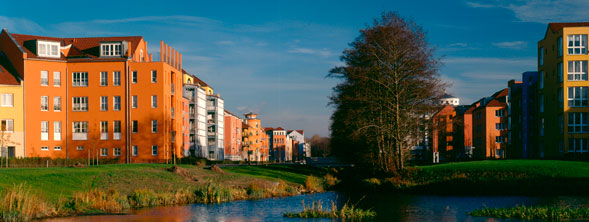
1. Februar 2008
Krier Kohl Architects brings order and meaning to cities torn apart by World War II and its lingering aftermath.
By Kim A. O’Connell
After the bombs of World War II had done their devastating duty, the German city of Potsdam was in ruins, with many of its glorious Prussian-era buildings severely damaged. Cut off by the infamous Berlin Wall, Potsdam suffered further in the post-war era when the remains of its historic city center were largely demolished rather than rebuilt. With the passage of time, however, the city has embraced its history and endeavored to restore its grandest old buildings, including the 18th-century Potsdam Castle Sanssouci. This work extends to a growing appreciation of traditional urban planning, as illustrated by the new village of Kirchsteigfeld.
Since its completion in 1996, the village has transformed a once-derelict field southeast of Potsdam. It remains one of the largest housing construction projects undertaken in the former East Germany since the country’s reunification. With three main sections grouped around a central market square, complete with a church, schools, shops and offices, Kirchsteigfeld represents the full realization of the New Urbanist ideal – a mix of uses, a thriving community and a distinct sense of place. Its vibrancy and variety are the handiwork of some 25 different architects, but the cohesiveness and logic of its master plan are due to one firm – Krier Kohl Architects.
Led by Rob Krier and Christoph Kohl, this Berlin-based office has designed a wide range of buildings and developed dozens of major urban-planning projects over the past 15 years. Both principals are committed to work that repairs the fabric of urban life, which they believe has been seriously undermined in the decades since World War II. „Modern cities are mainly constructed in freestanding buildings,“ says Krier. „The traditional type of urban villages disappeared in modern spaces after the last world war. You could see this dramatic loss of urban space in both new areas and the historical centers. Throughout my career, I have tried to rediscover the quality of traditional cities.“ […]
read full article: www.traditional-building.com
Kim A. O’Connell in: Traditional Building Magazine, February 2008.